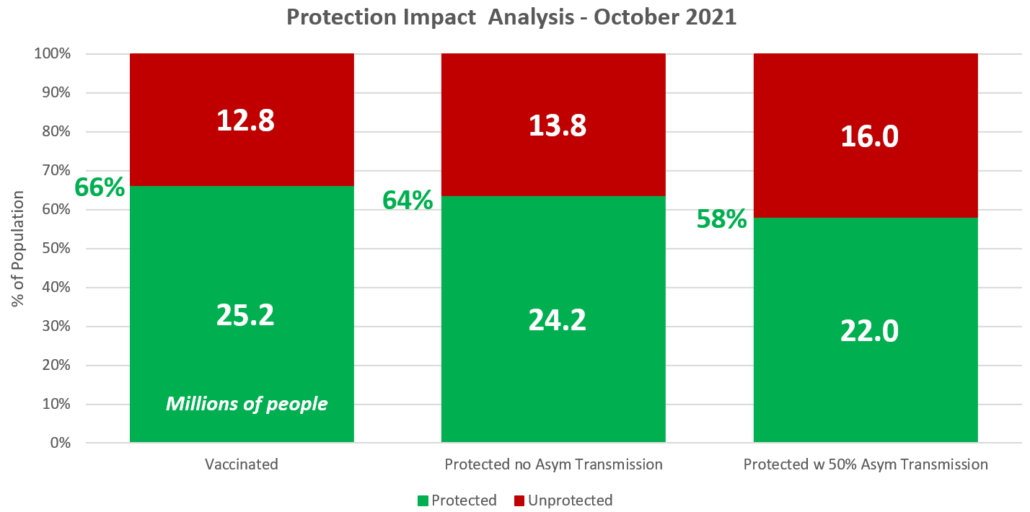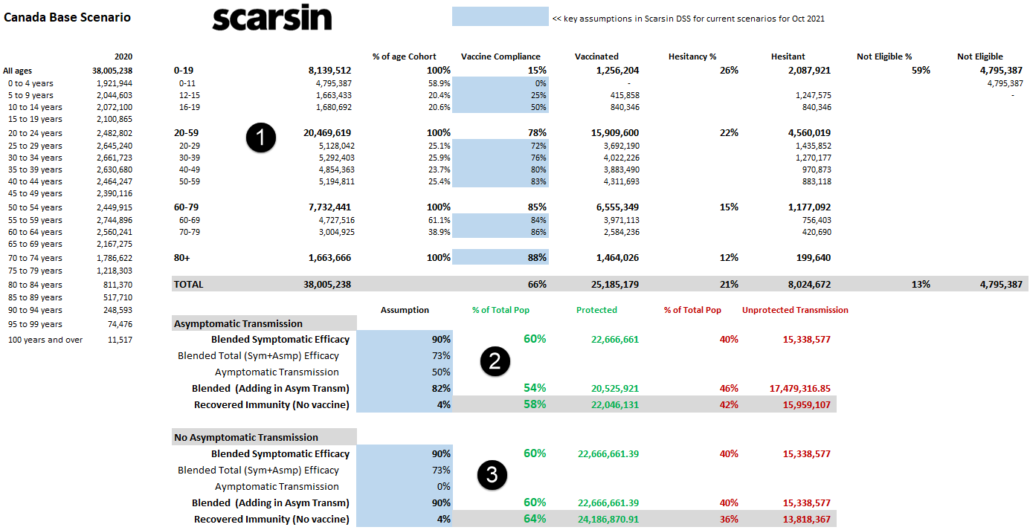Herd Immunity is Elusive but Canadians Can Be Optimistic
By Paul Minshull, CEO & Founder, Covid19 Solution Architect
As most areas in the country stagger under the onslaught of Wave III, there is ongoing chatter about accelerating vaccination getting Canada to “herd immunity”. But what is herd immunity? Will we ever get there? And does it matter anyway? For this article we built a medium- and long-range forecast for Canada that shows:
- Canada will likely not achieve herd immunity in 2021, and transmission threats will remain
- The most likely scenario is that approximately 58-64% of the population will have some form of immunity by October
- Canada will likely face a Wave IV in the Fall, but with lower risks than we saw in prior waves
- Things will improve dramatically in 2021, but not quite return to “full normal”
- We should expect some level of ongoing public health measures for the time being
Understanding Herd Immunity
The Association for Professionals in Infection Control and Epidemiology defines the term this way:
“Herd immunity (or community immunity) occurs when a high percentage of the community is immune to a disease (through vaccination and/or prior illness), making the spread of this disease from person to person unlikely. Even individuals not vaccinated (such as newborns and the immunocompromised) are offered some protection because the disease has little opportunity to spread within the community”.
Achieving pure herd immunity behavior, where life returns to normal and the transmission remains under natural control, requires a very high level of immunity from vaccination or from having recovered from an infection, both of which are likely beyond our reach in 2021.
The likely scenario for Canada — given the current information on vaccines, hesitancy levels and the dynamics of transmission with known variants — is that between 58% and 64% of the population will have immunity this year – well short of what is needed for Herd Immunity and setting the stage for a potential Wave IV.
Although the demographics and outcomes (hospitalizations and deaths) would be unique vs wave II and III. The most important features will be much lower average age of cases, less severity in those vaccinated with lower hospitalization and mortality rates. We also need to keep in mind the potential longer term impacts of Covid-19 on people’s health particularly with younger people be affected.
Risks and variables
In the chart below, we have summarized our analysis of two possible scenarios of Protection vs the vaccinations:
The left bar, uses current vaccination progress and supply data and assumes that 66% of the population, or 25-million people, including some in the 12-15 age group, are vaccinated by October and of that, more than 90% have received full doses. This is an encouraging scenario but will likely not deliver Herd Immunity.
The actual level of protected population is however different based on three key factors:
- A small percentage of vaccinated people can still contract and transmit symptomatic COVID-19 infections to others.
- Vaccinated people who develop asymptomatic COVID-19 may potentially transmit
- Some people who are not vaccinated (either because they are hesitant or too young) could have an immunity as a result of recovering from a previous infection.
When we included these factors in our analysis, we saw the effective protected population when there is no asymptomatic transmission and when there is 50% drop to 64% and 58% respectively.
The detailed analysis of this is contained at the bottom of the blog in Figure 2.
There is no empirical evidence currently about asymptomatic transmission in vaccinated people so we remain hopeful that the effective protection would be approximately 64%.
Figure 1 — Canada Protection Scenarios

There are, of course, a number of unknowns, most of which will generally increase risk, including:
- Waning efficacy over time with vaccines
- Increased vaccine escape with existing or new variants
- Major transmission on a global basis (India being a current example)
- Travel related risk from US and International visitors
- Transmission in asymptomatic vaccinated patients
- Unforeseen supply disruptions for vaccines
Improving our odds
Given the very real risks outlined above and the likelihood that we will not achieve herd immunity this year, our analysis highlights some clear pathways to protecting as many Canadians as possible:
Vaccinate children
As we are learning now, new variants do not spare younger people, and youth is not an absolute guarantee of a good outcome. If governments are committed to opening businesses, schools and daycare centres, they must include children in the vaccination strategy, (following public guidance), to reduce infection and prevent or limit a fourth wave in the Fall.
Reduce vaccine hesitancy
Negative reinforcement to reduce hesitancy, such as restricting access, offers a long-term benefit but will not help reduce transmission immediately. So positive reinforcement that generates those gains earlier will have a strong return on investment. Given the potential implications to public health and economic activity, all levels of government and the private sector should be innovating in their approach to changing the behaviour of people who are hesitant.
Evidence-based, proactive planning
With some notable exceptions, provincial governments have been reactive through subsequent waves of infection, often making the same mistakes over and over. We have a small window in which to formulate proactive strategies based on expert input. If we can use the coming months to communicate clear expectations with science-driven rationales to Canadians, we can use policy interventions to change behaviours and avoid another catastrophic wave in the Fall.
The bottom line
The good news is that things are going to improve significantly over the Summer and into the Fall as more and more Canadians get vaccinated. There will be a reduced risk of transmission as we move into the Fall and school opening compared to how we entered 2021, but not to the point where all public health measures can be fully relaxed.
No doubt there will still be some degree of masking requirements and social distancing which will be defined over the coming months. More proactive planning by Public Health and provincial governments can however mitigate those risks with clear updated guidance. Major issues in the Fall are avoidable, and we are hopeful that lessons learned in the past 14 months will be applied more effectively in the Fall.
Recommended reading
Scarsin approached this assumption and forecasting analysis independently but there are many consensus conclusions in other publications. The most recent paper, Report: Vaccination and reopening in Canada by P. Tupper, Y. Song, N. Mulberry, C. Colijn is must reading based on a rigorous and current analysis of herd immunity. The BC modeling and analytics teams have consistently provided strong and proactive analysis within Canada. For the purpose of their report, the team utilized a simpler designed SIR model. Scarsin will present specific longitudinal projections for 2021 based on its advanced SEVAISTHRD model in its upcoming blog.
Figure 2- Canada Protection Analysis

![scarsin logo black] Scarsin COVID 19](https://scarsin-covid.com/wp-content/uploads/2020/03/scarsin-logo-black.png)

Trackbacks & Pingbacks
[…] “The good news is that things are going to improve significantly over the summer and into the fall as more and more Canadians get vaccinated,” Minshull wrote in a recent analysis. […]
[…] “The good news is that things are going to improve significantly over the summer and into the fall as more and more Canadians get vaccinated,” Minshull wrote in a recent analysis. […]
[…] “The good news is that things are going to improve significantly over the summer and into the fall as more and more Canadians get vaccinated,” Minshull wrote in a recent analysis. […]
[…] “The good news is that things are going to improve significantly over the summer and into the fall as more and more Canadians get vaccinated,” Minshull wrote in a recent analysis. […]
[…] “The good news is that things are going to improve significantly over the summer and into the fall as more and more Canadians get vaccinated,” Minshull wrote in a recent analysis. […]
[…] «La bonne nouvelle, c’est que les choses vont s’améliorer considérablement au cours de l’été et à l’automne, car de plus en plus de Canadiens se font vacciner», a écrit Minshull dans un analyse récente. […]
[…] “La buena noticia es que las cosas van a mejorar significativamente durante el verano y el otoño a medida que más y más canadienses se vacunen”, escribió Minshull en un análisis reciente. […]
[…] “The good news is that things are going to improve significantly over the summer and into the fall as more and more Canadians get vaccinated,” Minshull wrote in a recent analysis. […]
[…] “The good news is that things are going to improve significantly over the summer and into the fall as more and more Canadians get vaccinated,” Minshull wrote in a recent analysis. […]
[…] “The good news is that things are going to improve significantly over the summer and into the fall as more and more Canadians get vaccinated,” Minshull wrote in a recent analysis. […]
[…] “The good news is that things are going to improve significantly over the summer and into the fall as more and more Canadians get vaccinated,” Minshull wrote in a recent analysis. […]
[…] That will sound disappointing, however Scarsin’s modelling additionally predicts what impact this degree of immunity may have on the severity of COVID-19. And on that entrance, the longer term seems to be quite a bit brighter. “The excellent news is that issues are going to enhance considerably over the summer time and into the autumn as an increasing number of Canadians get vaccinated,” Minshull wrote in a recent analysis. […]
[…] “The good news is that things are going to improve significantly over the summer and into the fall as more and more Canadians get vaccinated,” Minshull wrote in a recent analysis. […]
[…] “The good news is that things are going to improve significantly over the summer and into the fall as more and more Canadians get vaccinated,” Minshull wrote in a recent analysis. […]
[…] "The good news is that things are going to improve significantly over the summer and into the fall as more and more Canadians get vaccinated," Minshull wrote in a recent analysis. […]
[…] “The good news is that things are going to improve significantly over the summer and into the fall as more and more Canadians get vaccinated,” Minshull wrote in a recent analysis. […]
[…] “The good news is that things are going to improve significantly over the summer and into the fall as more and more Canadians get vaccinated,” Minshull wrote in a recent analysis. […]
[…] “The good news is that things will improve dramatically during the summer and into the fall as more and more Canadians are vaccinated,” Minchol wrote in the letter. Final analysis. […]
[…] “The excellent news is that issues are going to enhance considerably over the summer season and into the autumn as an increasing number of Canadians get vaccinated,” Minshull wrote in a recent analysis. […]
[…] “The good news is that things are going to improve significantly over the summer and into the fall as more and more Canadians get vaccinated,” Minshull wrote in a recent analysis. […]
[…] “The good news is that things are going to improve significantly over the summer and into the fall as more and more Canadians get vaccinated,” Minshull wrote in a recent analysis. […]
[…] “The good news is that things are going to improve significantly over the summer and into the fall as more and more Canadians get vaccinated,” Minshull wrote in a recent analysis. […]
[…] “The excellent news is that issues are going to strengthen considerably over the summer time and into the autumn as increasingly Canadians get vaccinated,” Minshull wrote in a recent analysis. […]
[…] “The excellent news is that issues are going to enhance considerably over the summer time and into the autumn as increasingly more Canadians get vaccinated,” Minshull wrote in a recent analysis. […]
[…] “The good news is that things are going to improve significantly over the summer and into the fall as more and more Canadians get vaccinated,” Minshull wrote in a recent analysis. […]
[…] “The good news is that things are going to improve significantly over the summer and into the fall as more and more Canadians get vaccinated,” Minshull wrote in a recent analysis. […]
[…] “The good news is that things are going to improve significantly over the summer and into the fall as more and more Canadians get vaccinated,” Minshull wrote in a recent analysis. […]
[…] “The good news is that things are going to improve significantly over the summer and into the fall as more and more Canadians get vaccinated,” Minshull wrote in a recent analysis. […]
[…] “The good news is that things are going to improve significantly over the summer and into the fall as more and more Canadians get vaccinated,” Minshull wrote in a recent analysis. […]
[…] “The good news is that things are going to improve significantly over the summer and into the fall as more and more Canadians get vaccinated,” Minshull wrote in a recent analysis. […]
[…] “The good news is that things are going to improve significantly over the summer and into the fall as more and more Canadians get vaccinated,” Minshull wrote in a recent analysis. […]
[…] «La bonne nouvelle, c’est que les choses vont s’améliorer considérablement au cours de l’été et à l’automne, car de plus en plus de Canadiens se font vacciner», a écrit Minshull dans un analyse récente. […]
Comments are closed.